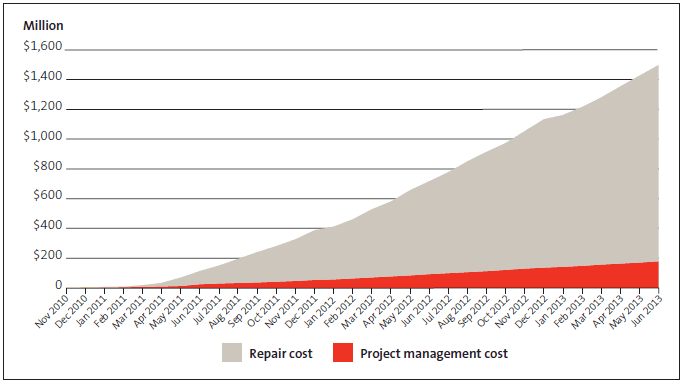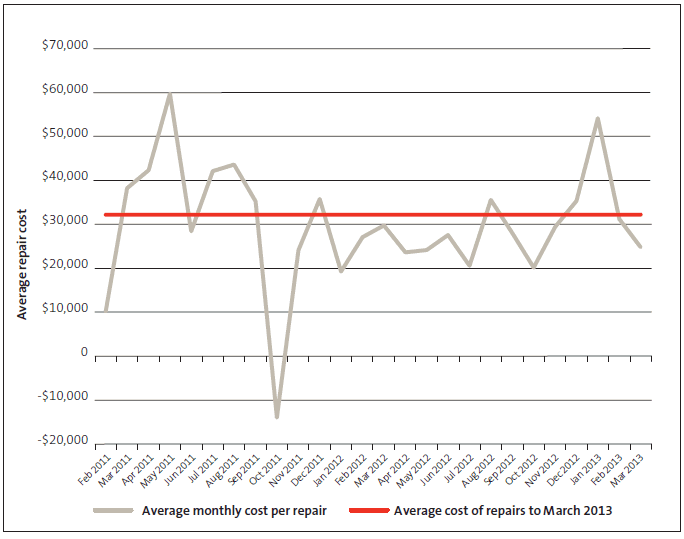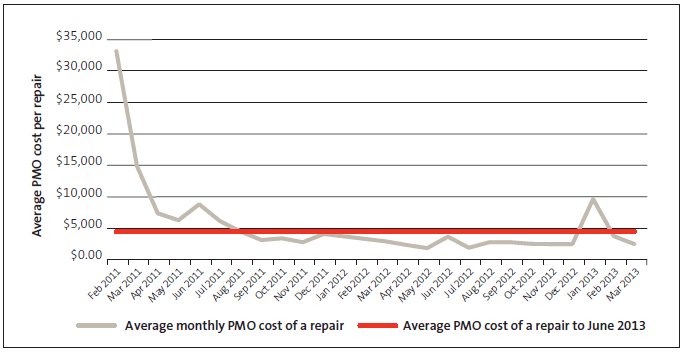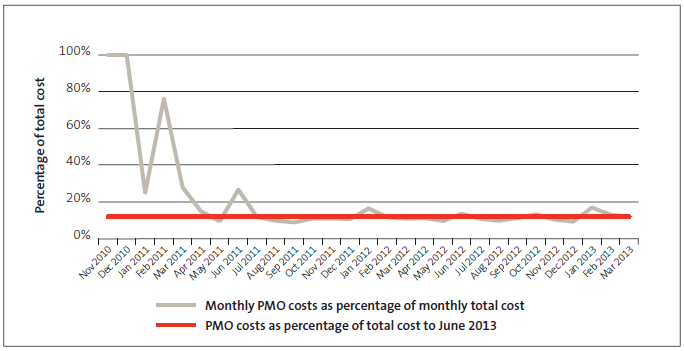Part 6: Efficiency of the home-repair programme
6.1
In this Part, we assess the efficiency of the home-repair programme. Efficiency refers to the extent to which resources are used in the best way.
6.2
If resources are not used in the best way, there will be waste, the cost of elements of the home-repair programme might be higher than necessary, and resources might be lost through inappropriate behaviour (such as fraud). If the programme is not managed efficiently, then it might not deliver repairs within the expected cost.
6.3
We look at:
Summary of our findings
6.4
Repair costs have been reasonable to date, but there are risks to that continuing. Repair-cost inflation has been at about the national inflation rate for construction, and less than in Canterbury generally. EQC has implemented controls to keep repair costs within market norms. Hourly labour rates have been kept static.
6.5
Keeping repair costs at a reasonable rate depends on EQC continuing to manage controls and systems well, staying ahead of the private insurance and central city repair and rebuild work, and completing the home-repair programme by the December 2014 deadline that EQC has set.
6.6
We have obtained indicative project management costs from various sources, including confidential information from several other organisations. The information suggests that project management costs (on average, about 12% of the cost of a repair) have been at the higher end of what we consider reasonable in the circumstances.
6.7
Achieving reasonable project management costs at the end of the home-repair programme depends heavily on EQC:
- completing the home-repair programme by December 2014;
- managing the hub reconfiguration project effectively to deliver the expected benefits; and
- continuing to control repair-cost inflation because Fletcher Construction receives a fixed proportion of repair costs as a fee.
6.8
EQC's initial controls for fraud prevention and investigation and conflicts of interests were not appropriate to the scale and nature of the home-repair programme. EQC has sought professional advice about fraud risks and used this advice to inform its work. It has also increased the number of staff working on fraud controls, and improved its controls for conflicts of interests.
Total cost
The total cost of the home-repair programme to June 2013 was about $1.5 billion. We estimate that the overall cost of the home-repair programme will be between $2.5 and $3.1 billion.
6.9
To 30 June 2013, the total cost of the home-repair programme was about $1.5 billion. This is made up of $1.3 billion in repair costs (including the home-heating and emergency-repair initiatives) and $180 million in project management costs.
6.10
Figure 17 shows the cumulative monthly cost of the home-repair programme to June 2013. The proportion of the total cost made up by repair costs and by project management costs is also shown.
Figure 17
Cumulative costs by month, November 2010 to June 2013

Note: Our analysis, based on information provided by EQC.
6.11
We have analysed information provided by EQC and Fletcher Construction using various scenarios to estimate how much the home-repair programme will cost once it is completed. At this stage, we estimate that the total cost of the programme will be between $2.5 billion and $3.1 billion, and project management costs will be around 10%-12.5% of the total.
6.12
It is difficult to provide a more precise estimate of the total programme costs because of the sensitivity of costs to the assumptions we have made. In particular, the estimate is sensitive to assumptions about:
- inflation in the cost of repairs;
- the scale of the average repair;
- the effect of EQC's decision to complete the home-repair programme at the end of 2014 instead of the end of 2015; and
- gaining the financial benefits expected from reconfiguring the repair hubs.
6.13
It is critical that EQC manages its hub reconfiguration project effectively to deliver the expected benefits, including financial benefits, and continues to be successful in controlling repair-cost inflation. If EQC does not achieve these, there is a risk to the efficiency of the programme and, in particular, a risk that the final project management costs will be at the upper range of what might be reasonable in the circumstances.
Repair costs
Repair costs have been reasonable to date. Keeping repair costs at a reasonable rate depends on EQC continuing to use controls well, staying ahead of the private insurance and central city repair and rebuild work, and completing the home-repair programme by the December 2014 deadline that EQC has set.
6.14
To date, $1.3 billion has been spent on repair costs in the home-repair programme. This figure includes the cost of the home-heating and emergency-repair initiatives but excludes project management costs paid to Fletcher Construction.
6.15
Figure 18 shows the average cost to repair a house in the home-repair programme, by month. The average cost has fluctuated between $10,000 and $60,000 for each house, but has been between $20,000 and $30,000 in many months.
Figure 18
Average cost to repair a house in the home-repair programme, by month, February 2011 to March 2013

Notes: This is our analysis, based on information provided by EQC. The costs shown reflect "substantive works (core repair work outside of emergency works and clean heat)". EQC's information includes a negative value for October 2011. EQC told us that this is because of a "re-classification" of repair costs with the introduction of an "urgent" category. In effect, the negative expenditure is a credit to the "substantive works" category for costs incurred in that category, up to that point, that were not "substantive works".
6.16
Based on EQC's 2012/13 business plan, by the end of the home-repair programme, Fletcher Construction projects that the average cost of a house repair (excluding project management) will be about $31,000. Based on this average, the total cost of the remaining repairs in the programme (excluding project management) is projected to be about $1.2 billion. This will bring the total projected repair costs to about $2.5 billion.
6.17
However, this cost depends, in part, on actual repair-cost inflation, the effect of this on the average cost of a repair, the rate of homeowners opting out (that is, choosing to organise their own repairs), and the rate of repair jobs exceeding the $100,000 cap during repairs. When all these factors are taken into account, we estimate that the total cost of repairs in the home-repair programme will be between $2.2 and $2.7 billion.
Risks to the cost of repairs
Risks of inflation in the cost of repairs
6.18
Repairs are costed in units that combine the costs of materials and labour needed to complete a specific type of repair – for example, a unit cost for painting a square metre of an internal wall. Fletcher Construction provided us with information indicating that, based on its regular sampling of completed repairs, between 60% and 70% of the repair unit costs are labour costs. The hourly labour rate assumed in the home-repair programme has remained unchanged.
6.19
The approach EQC is taking to containing repair-cost inflation runs the risk of repair work being priced at the rates ceiling price, rather than being up to a rates ceiling price. This is because each time a contractor bids for a job they have, in effect, the opportunity to test the ceiling rate. Some contractors are bidding on large numbers of jobs throughout multiple repair hubs. For example, about 300 accredited contractors are responsible for 85% of the completed home-repair work to date. We spoke with hub staff who were clear that some contractors had a good understanding of the rate ceiling prices, and information about the labour costs assumed in the rates ceiling prices has been in the public arena.
6.20
Generally speaking, for each repair job, only one accredited contractor is asked to quote for the work. Potentially higher costs because of only one quote are a trade-off in the circumstances. The risks of higher quotes will, to some extent, be ameliorated by the rates ceiling approach.
6.21
If a contractors' quote exceeds the rates ceiling price, a quantity surveyor is expected to examine the nature of the repair work required for anything that might not be factored into the rates ceiling price. If the nature of the repair work does not justify pricing above the rates ceiling, there is an expectation that a quote will be obtained from another contractor.
6.22
The rates ceiling arrangements appear to have been operating for a long period without a structured process for regular review. When we drafted this report, EQC was setting up a regular quarterly review mechanism for rates ceiling changes. The mechanism is intended to include external professional review of rates ceiling changes against current market rates.
6.23
EQC has done some modelling of rates ceiling changes by examining changes in the cost of a "basket" of repair units required for the "typical" repair. The results of EQC's modelling indicate about a 6% increase in the cost of a "typical" repair between the first earthquake and April 2013. This is consistent with the change in Statistics New Zealand's price index for the construction of dwellings during a similar period.
6.24
EQC indicated that some of the reasons for increases in rates ceiling schedule costs include:
- new building code requirements requiring stronger brick work; and
- more time being added to some repair units involving sanding and preparation of services for painting.
The supply of building materials
6.25
Bulk supply contracts are in place for plasterboard (and associated fasteners, adhesives, and joining compounds) and paint. In mid-February 2013, the PCG was advised that the paint supply agreement had failed because of "non-compliance from the painters". Subsequently, Fletcher Construction has indicated that the paint supply agreement has resulted in a small discount for the contractor at the point of purchase.
6.26
EQC's work with MBIE on bulk procurement should continue. MBIE is working with public entities in Canterbury on bulk procurement matters.
Fraud risks
6.27
During 2012 and 2013, EQC increased the size of its team (from 10 people to 19 people) that scrutinises claims for fraudulent behaviour. This is the Claims Review Team. The Claims Review Team has commissioned and received advice on the inappropriate behaviour risks it needs to identify and manage. The Claims Review Team plans to focus on contractor and contract supervisor risks in the home-repair programme in 2013. The Claims Review Team's work covers all aspects of EQC's work, not just the home-repair programme.
6.28
Fletcher Construction also has fraud investigative capacity within the home-repair programme. EQC's internal audit work has identified the need for better integration of fraud reporting, recording, and investigation between Fletcher Construction and EQC. A joint fraud strategy is planned.
6.29
EQC has identified a number of inappropriate behaviours that could potentially occur in the home-repair programme. These include:
- claiming for repair work that was not earthquake related;
- claiming for repair work that includes improvements not required to return a house to the state it was in before the earthquakes;
- invoicing for repair work that has not been completed or carried out;
- creating or altering invoices to contain false information;
- creating or altering engineering reports to contain false information;
- inflating invoices;
- using inappropriately obtained information to inform quotes;
- invoicing for material or items not used in a repair; and
- charging more than once for the same work.
We saw an example of an alleged invoicing fraud during our visits to repair hubs.
6.30
The most common types of fraud that we have identified in the public sector18 are:
- theft of cash;
- theft of plant, equipment, or inventory;
- fraudulent expense claims;
- payroll fraud; and
- false invoicing.
6.31
Fraudulent claims and false invoicing feature in the types of potentially inappropriate behaviour that EQC has identified could occur in the home-repair programme. This is consistent with the types of fraud that have occurred in public entities.
6.32
EQC has noted that, in all of its insurance work, including the home-repair programme (as at 23 May 2013):
- it has investigated about 900 instances of suspected fraud;
- 21 have been referred to the Police, and five of these have resulted in convictions;
- individual instances of fraud detected within the home-repair programme range from $5,000 to about $150,000 in value; and
- the Claims Review Team's work has saved more than $5.5 million.
6.33
We support EQC continuing to work with other public entities on how to further reduce the risks of fraud and other inappropriate behaviour.
Conflicts of interest risks
6.34
EQC has clear expectations about declaring conflicts of interest, and the expectations are outlined in a policy for its staff. This policy and the associated disclosure form were updated in March 2013. Before the update, there was a greater risk that EQC's staff within the home-repair programme did not consider or declare non-financial conflicts of interest and perceived conflicts of interest. The updated policy and form have made it clearer that these matters should be considered as conflicts of interest and are required to be declared.
6.35
Internal audit work within the home-repair programme has identified the need for improved conflict of interest management throughout the whole programme, covering both Fletcher Construction and EQC staff within the home-repair programme. The internal audit work also found that the recommendations to address this matter have been carried out.
Project management costs and risks
Our analysis suggests that project management costs (on average, about 12% of the cost of a repair) have been at the higher end of what we consider reasonable in the circumstances. Achieving reasonable project management costs at the end of the home-repair programme depends heavily on EQC completing the home-repair programme by December 2014, managing the hub reconfiguration project effectively to deliver the expected benefits, and continuing to control repair-cost inflation.
6.36
In total, $180 million had been spent on project management costs to the end of June 2013.
6.37
Average project management costs have been about $4,500 for each repaired house in the home-repair programme to June 2013. Figure 19 shows the average project management costs in the programme by month. Those costs have been higher during the early stages of the programme because of set-up costs.
Figure 19
Average project management costs for a repaired home by month, February 2011 to March 2013

Notes: Our analysis is based on information provided by EQC. We have excluded the early months of the home-repair programme from the figure because of the effect of set-up costs. The spike in average cost in January 2013 was because of the effect of the holiday period, when fewer repairs were completed.
6.38
The project management costs we describe in this report are covered by EQC's contract with Fletcher Construction. They include the cost of Fletcher Construction's staff, buildings and equipment, and a margin on the cost of repairs.
6.39
The project management costs exclude the staff employed by EQC to administer and manage the home-repair programme contract, including the overall programme manager and the EQC staff located in repair hubs. Those staff are included in the costs of the Canterbury Home Repair Programme Business Unit within EQC's Customer Services Group. At 30 June 2013, about $20 million has been spent on the Canterbury Home Repair Programme Business Unit.
6.40
EQC followed a sound process in the circumstances to procure project management services for the home-repair programme. It acted quickly in setting up the home-repair programme and the project management services contract. These were done in circumstances that involved many uncertainties and additional earthquakes.
6.41
The final contract is a "cost-plus" contract, which means that Fletcher Construction recovers the actual costs it incurs in providing the project management services, and a fee linked to the value of repair work completed. The fee is a 3.5% margin on the value of the completed repair work.
6.42
There is no directly comparable information available about the market cost of project management services for a home-repair programme. We have obtained a number of indicators of project management costs from various sources:
- the professional assessment of the cost of project management services in the two short-listed bids received by EQC;
- the actual project management costs in the programme compared to those anticipated in the successful bid, noting that assumptions were made at the time of the bid that have proved to be invalid because of multiple earthquakes;
- professional advice to an insurer assessing the market price for project management services (we have agreed to maintain the confidentiality of this information);
- the actual project management costs being paid by an insurer involved in the recovery (we have agreed to maintain the confidentiality of this information);
- the actual margins paid by an entity on a range of construction jobs (we have agreed to maintain the confidentiality of this information);
- independent advice provided to EQC on aspects of project management costs for different types of building projects; and
- a reinsurer's report about EQC's claims-handling costs (we have agreed to maintain the confidentiality of this information).
6.43
We have compared the most relevant information from each of these indicators with the equivalent aspects of actual project management costs in the home-repair programme. The comparisons do not provide a definitive view on the appropriateness of the project management costs, but they do provide indicative information.
6.44
On average, project management costs have decreased during the home-repair programme as a proportion of the total cost of repairing a house. To June 2013, project management costs were, on average, about 12% of the total cost (project management and repair costs combined) of repairing a house in the programme. The percentage continues to fluctuate by month (see Figure 20).
Figure 20
Project management costs as a proportion of the total cost for a repaired home, by month, November 2010 to March 2013

Note: Our analysis based on information provided by EQC.
6.45
We estimate that total project management costs for the home-repair programme will be between $288 million and $333 million. This equates to an estimated average project management cost for each repaired house of between $3,900 and $4,500.
Risks to project management costs
Risks of using a single provider of project management services
6.46
EQC could have contracted with more than one project management provider to contain project management cost risks. EQC's RFP for project management services envisaged the possibility of multiple providers of those services. This has not happened because EQC decided that having more than one provider would have higher transaction costs for EQC and would also involve providers competing against each other for tradespeople and building materials. Given the circumstances, we understand this approach.
6.47
To mitigate against the risk of paying the provider of project management services for poor performance, because of the "cost-plus" nature of the contract for those services, there are arrangements in the contract that give EQC complete control of whether or not it refers repair work to Fletcher Construction. If it chose to, EQC could allocate work to an alternative provider.
6.48
EQC was revisiting the repair hub structure and configuration when we were drafting this report. EQC's stated goals of the hub rationalisation are to:
- enhance claimant and contractor experience;
- provide a platform for improving efficiency and consistency; and
- improve communication throughout the hub network.
6.49
In our view, EQC needs to maintain ongoing scrutiny of the scale, configuration, type, and cost of project management services in the home-repair programme. This includes taking any opportunities that arise as the project progresses to use additional relevant information to inform decisions about project management costs.
Risks of conflicts of interest
6.50
There are some conflict of interest risks inherent in the design of the home-repair programme. These are with the role of quantity surveyors working for Fletcher Construction and the role of Fletcher Construction more generally.
6.51
There is limited independent review of Fletcher Construction's quantity surveyor assessments of proposed repair strategies or sign-offs of repair quotes. There is a risk that inflated prices could be paid for repair work through quantity surveyors accepting higher cost quotes or altering the EQC reserve amount against which invoices are compared before being paid. These risks are, to some extent, ameliorated by the price ceiling approach used in the programme.
6.52
The contract between EQC and Fletcher Construction requires Fletcher Construction to use "reasonable endeavours" to ensure that conflicts of interest do not arise with its project management role. A clear conflict of interest would arise if Fletcher Construction was, for example, carrying out some of the repairs.
6.53
The project management contract does not prohibit Fletcher Construction from carrying out repair work. It requires both EQC and Fletcher Construction to agree that contractor capacity constraints are "unduly limiting the rate of reinstatement" before the possibility of Fletcher Construction carrying out repair work can be contemplated. This had not been necessary at the time we published this report.
6.54
This appears to be a pragmatic way of balancing the potential conflict of interest risks with a possible solution to a capacity problem if one arises in the circumstances. Stringent cost protections would need to be included if Fletcher Construction were to directly carry out repair work.
17: EQC provided the actual and projected cost information used in this report. We have not independently verified the information, but we do carry out annual audits of EQC's financial statements.
18: See Fraud awareness, prevention, and detection in the public sector, available at our website: www.oag.govt.nz.
page top
